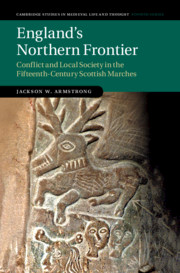Book contents
- England’s Northern Frontier
- Cambridge Studies in Medieval Life and Thought
- England’s Northern Frontier
- Copyright page
- Dedication
- Contents
- Figures
- Maps
- Acknowledgements
- Abbreviations
- 1 Introduction
- Part I
- Part II
- Part III
- 6 The Administration of Justice
- 7 Patterns of Conflict
- 8 Cross-Border Conflict
- 9 Discord
- 10 Concord
- 11 Conclusions
- Bibliography
- Index
10 - Concord
from Part III
Published online by Cambridge University Press: 30 October 2020
- England’s Northern Frontier
- Cambridge Studies in Medieval Life and Thought
- England’s Northern Frontier
- Copyright page
- Dedication
- Contents
- Figures
- Maps
- Acknowledgements
- Abbreviations
- 1 Introduction
- Part I
- Part II
- Part III
- 6 The Administration of Justice
- 7 Patterns of Conflict
- 8 Cross-Border Conflict
- 9 Discord
- 10 Concord
- 11 Conclusions
- Bibliography
- Index
Summary
This chapter continues an investigation of accustomed practices of conflict management in the far north, chiefly in the making of peace by compromise – or the other side of feud. It continues to pursue the question of how far a normative framework of disputing other than that of royal justice and its usual out-of-court practices is detectable, recalling that the system of border justice was itself heavily concerned with processes of reparation and conversant with broader frameworks of justice familiar in other parts of Europe, including Scotland. As a type of dispute heavily reliant on customary practices, feud remains in the forefront of attention, as do the feud-like elements of compromises. As we have seen, dispute resolution by arbitration is a well-studied feature of late medieval conflict, and the evidence for it in the border counties will be surveyed, as will be the role of supporters and peacemakers. We shall then turn to the attempted resolution of violent disputes, to investigate the objectives of peacemaking in serious conflict. In drawing comparisons with the rest of England, the general question about the distinctiveness of the far north in all this remains to the fore. All the same, in tracing accustomed practices of conflict management, our analysis moreover will reconsider the view, relevant to all of England, that genuine efforts at pacification were primarily concerned to restore a pre-existing orderly state of affairs. Discord was not simply a matter of order upset; concord was not simply the settlement of disputes or the quelling of disorder. Instead, peacemaking’s potential to construct social relationships will be explored, especially with regard to the feud-like elements of ceremonial reconciliation, compensation and the exchange of formal contracts. The extent to which these processes reveal a customary normative framework of disputing is crucial to the final assessment of the normative balance of conflict management in the marches.
- Type
- Chapter
- Information
- England's Northern FrontierConflict and Local Society in the Fifteenth-Century Scottish Marches, pp. 308 - 336Publisher: Cambridge University PressPrint publication year: 2020

